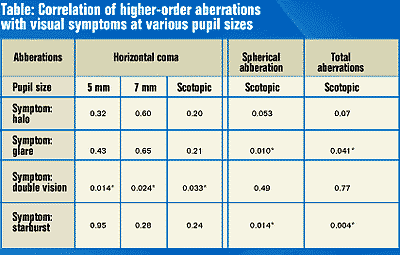Wavefront maps help surgeons correlate visual symptoms with aberrations
Pupil diameter is key to understanding maps, patients’ visual outcomes.
Wavefront analysis is a tool that helps ophthalmic surgeons compare the optical quality of a patient’s eye with the optics of an ideal, perfectly focused eye. The depth of information provided by a wavefront analysis system, such as Alcon’s LADARWave, allows the surgeon to perform a customized ablation with the LADARVision 4000 to correct higher-order aberrations beyond the lower-order terms of defocus (sphere) and astigmatism (cylinder). The technology also allows surgeons to correlate specific types of aberrations with the visual complaints of the patient. Potentially, wavefront analysis can more accurately assess and correct many types of optical irregularities, even those after a refractive procedure that leaves the patient unsatisfied.
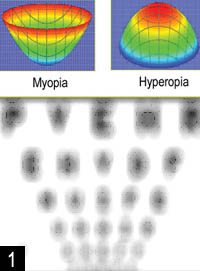 Top: Three-dimensional representations of wavefronts for myopia and hyperopia. Bottom: Effect of defocus (myopia, hyperopia) on visual image. (All images courtesy of Ronald R. Krueger, MD.) |
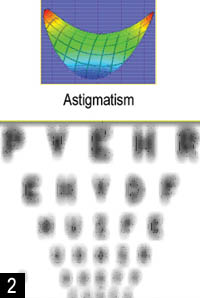 Top: Three -dimensional representations of wavefront for astigmatism. Bottom: Effect of astigimatism on visual image. |
Wavefront mapping alone, however, does not provide all of the necessary information. Surgeons must perform a clinical refraction, both manifest and cycloplegic; note the status and history of the patient; and do a slit-lamp exam. Other tests that a surgeon may perform when interpreting the patient’s overall visual condition include dilated fundus exam, keratometry, corneal topography, pupillometry, tear film testing and contrast sensitivity.
One of the important features of the LADARWave is that it collects wavefront data with a dilated pupil to maximize the amount of total aberrations captured and, subsequently, the amount of aberrations that can be treated. The printout includes an assessment of the wavefront at the maximally captured pupil diameter. LADARWave can also assess the wavefront at other predetermined pupil diameters of lesser size. In fact, every time you look at a wavefront map, you cannot make a fair assessment about what is going on with that patient unless you first look at the pupil diameter of the wavefront measurement. This is necessary to establish a point of reference for interpretation of the eye’s aberrations.
The pupil diameter provides the key to knowing the significance of the magnitude of the aberrations reported. The same value of aberrations may be clinically insignificant at a 7-mm pupil size compared with a 5-mm pupil, where they may be of high enough value to be clinically symptomatic. The measurement of the wavefront with a dilated pupil facilitates capture of both central and peripheral aberrations, which is essential when performing a customized correction. This is why it is critical to perform wavefront measurements intended for surgery on a dilated pupil.
Specific aberration information
Wavefront maps provide specific information regarding aberrations expressed in microns of deviation from an ideal planar wavefront. The printout contains both two- and three-dimensional maps that reflect total aberrations and higher-order aberrations. The major refractive aberrations that we are used to seeing are defocus (myopia and hyperopia) and astigmatism.
The wavefront map depicts the level of myopia or hyperopia and astigmatism in ways that may be a bit unfamiliar and even counterintuitive to what we know from the color representations of corneal topography. In Figure 1, myopia and hyperopia are shown as a “blue bowl” and “red inverted bowl” respectively, representing a rotationally symmetric wavefront error, which induces the anticipated myopic or hyperopic blur in a distance visual image.
The blue depressed area of myopia represents the portion of the wavefront where the rays of light travel more slowly compared with the surrounding rays. Hence, all these rays converge at a crisp focal point in front of the eye, allowing one to see clearly at near. The red elevated wavefront in hyperopia represents a converging pattern of rays, which do not have any focus in front of the eye. These errors, represented three-dimensionally, are in contrast to the blue (flat cornea) or red (steep cornea) of corneal topography, which represent relative levels of corneal hyperopia and myopia, respectively.
In Figure 2, the wavefront map of astigmatism appears as a “saddle” shape. As we know, the visual image of simple astigmatism is directionally blurry along the meridian of error but may be sharply in focus along its axis. Pure (mixed) astigmatism as represented in Figure 2 has red and blue areas, defining the meridians of myopia (bowl) and hyperopia (inverted bowl), respectively. In the case of astigmatism, the green center relative to the red elevated periphery defines the myopic meridian, whereas the green center relative to the blue depressed periphery defines the hyperopic meridian. Here the center, which is neither blue nor red, represents a bowl (or converging rays) in one meridian and an inverted bowl (or diverging rays) in the other meridian 90° apart.
These second-order aberrations (myopia, hyperopia and astigmatism) can be corrected with spectacles and conventional refractive surgery because they are based on symmetrical optics. The shapes of the wavefront maps for the individual higher-order aberrations are more complex because they are based on asymmetric optics. Although they may be a bit trickier to interpret clinically, they can be understood by the relative areas of myopia and hyperopia, or pattern of converging and diverging rays.
Higher-order aberrations
In Figure 3, coma, which is a third-order aberration, tends to assume a “bump and dip” shape, or red inverted bowl next to a blue bowl. The optical effect of simple coma is to defocus one hemimeridian relative to all others. Pure coma, as represented in Figure 3, displays one hemimeridian as relative myopia (blue) and the opposite hemimeridian as relative hyperopia (red), creating the type of blurriness depicted in the corresponding visual image.
 Top: Three-dimensional representation of wavefront for coma. Bottom: Effect of coma on visual image. | 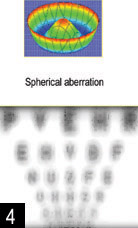 Top: Three-dimensional representation of wavefronts for spherical aberration. Bottom: Effect of spherical aberration on visual image. |  Top: Three-dimensional representation of wavefront for secondary astigmatism. Bottom: Effect of secondary astigmatism on visual image. |
In Figure 4, spherical aberration is a fourth-order aberration represented as a kind of “sombrero” shaped map. Its wavefront shape is defined as a central red hyperopic area surrounded by a peripheral blue myopic area. Here the asymmetry of the wavefront is central diverging rays with peripheral converging rays, the combination characterizing positive asphericity. The effect of positive spherical aberration is to induce a whole halo of blur around the edge of the image, and patients with significant spherical aberration often complain of halos and glare. It is now well recognized that the conventional LASIK ablation pattern in all excimer laser platforms tends to induce spherical aberration. Spherical aberration and coma are especially problematic in post-refractive surgery patients because they cannot be corrected with spectacles or retreatment with conventional refractive surgical procedures.
Other third- and fourth-order aberrations include secondary astigmatism, trefoil and tetrafoil. Of these, the most visually significant is secondary astigmatism, which is shown in Figure 5. Its wavefront shape is defined by two red hyperopic areas along one meridian and two blue myopic areas along the other, 90° apart. Like astigmatism, the very center of the wavefront is myopic along one meridian and hyperopic along the other, but this changes in the periphery to an opposite hyperopic and myopic pattern respectively. Although the visual acuity in these patients may not always be that poor, they often see double images, which can be quite disturbing. These aberrations also cannot be corrected by conventional means.
|
Clinical impressions
The LADARWave printout is a very useful way of showing the subtle aspects of small amounts of hyperopia, cylinder and higher-order aberrations, which may be consistent with good Snellen acuity but are present and causing visual symptoms nonetheless. Wavefront mapping is a highly resolvable technology that shows details beyond what ophthalmologists can detect clinically. This is part of what makes wavefront analysis of such great value to clinicians.
An example of low to moderate myopia of approximately 4 D is shown in Figure 6. The LADARWave map computes the patient’s refraction from five captures of the Shack-Hartmann aberrometry data (shown at the bottom center of Figure 6). The three data sets that most closely match (shown here in green) are averaged to arrive at the numerical values for each aberration, which are shown on the printout at the bottom right. The aberrations are categorized and calculated as RMS average deviation from a planar wavefront, measured in microns.
The most significant aberration for the patient in Figure 6 is defocus, which is the 4 D of myopia already described. The very top of each map on the printout notes the diameter of the pupil, which is being analyzed. If the wavefront measurements are made when the pupil is small, such as 4.9 mm in this eye, the numbers for almost every type of aberration will be lower than if measurements are made with a larger pupil.
The LADARWave printouts also represent aberrations graphically. The left-hand map shows total aberrations, and the right-hand map shows only the higher-order aberrations. The left-hand map of Figure 6 is actually a two-dimensional representation of the bowl shape shown in Figure 1.
The wavefront map of a hyperopic eye will have an inverted-bowl shape that is represented two-dimensionally as shown in Figure 7. In this case, the map shows “hot” values centrally, and the printout again lists the refractions, aberration values and pupil size.
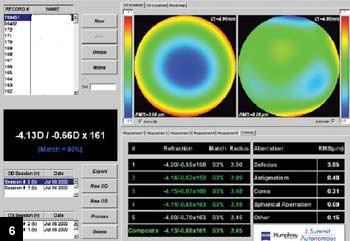 Example of LADARWave printout for low to moderate myopia (this patient is -4 D). |
 Example of LADARWave printout for low to moderate hyperopia (this patient is +2.2 D). |
Pupil diameter crucial
Pupil diameter is crucial to the overall understanding of the wavefront map and the patient’s visual outcomes. For example, consider a patient with keratectasia after LASIK (Figure 8). Wavefront maps for this patient show very different shapes and numbers when a 4-mm vs. a 7-mm pupil is examined. a 4-mm pupil, the sphere term is almost plano and there is little myopic cylinder. The value changes to more than half a diopter of myopia in the 7-mm pupil, and the higher-order aberrations are of a much higher magnitude.
In examining some of our patients, my colleagues and I noticed that the coma value actually went down with a larger pupil. We asked how that was possible because we know that whenever you go to a bigger pupil you get more aberrations. The fact is that when you change pupil diameter, you change the Zernike expression of the aberrations into different terms. So what previously was seen as coma may now be seen as secondary astigmatism because the aberrations change with a larger pupil. Knowing the pupil diameter is crucial for consistency of measurements over time.
Aberrations, symptoms
The patients whom practitioners are most eager to address in clinical practice are those with post-refractive surgery symptoms. For example, Figure 9 shows a wavefront map from a radial keratotomy patient with complaints of double vision 30% of the time. The printout shows that there is not much difference between the total aberrations and the higher-order aberrations; the two maps are nearly identical. At a pupil size of 7 mm, the sphere and cylinder terms are nearly neutral, so the patient ended up with a pretty good result. But the wavefront map shows that there is a lot of tetrafoil (blue areas of the map with four adjacent yellow areas in the periphery). The value of 1.96 µm RMS for these other aberrations is quite high.
These LADARWave maps are also very helpful in other unconventional patients, such as a post-myopic LASIK ablation with a subsequent astigmatic keratotomy (Figure 10). There is good visual acuity, but the map identifies residual astigmatism, spherical aberration, coma and other higher-order terms. It is no surprise to hear that the patient complained of halos and starburst, considering the presence of these aberrations.
Clinical symptoms
These unusual postoperative case examples show that the large dynamic range of the LADARWave system (+15 D to —15 D with 8 D of astigmatism) gives it the ability to capture highly aberrated eyes as well as very subtle aberrations. The system defines these aberrations to allow the practitioner to correlate them with visual symptoms at a given pupil size. I have been gathering wavefront data on a series of aberrated eyes so that we can further resolve the importance of higher-order aberrations in connection with visual symptoms.
In analyzing 105 eyes with previous surgery, a statistically significant relationship was found between horizontal coma and double vision (P = .033), as well as between spherical aberration and glare (P = .010) and starburst (P = .014) when correlating these at the patients’ scotopic pupil size. This illustrates the important influence of higher-order aberrations in affecting quality of vision and leading to clinical symptoms after surgery, as well as the need to detect and correct for these aberrations. My impression at this time is that wavefront analysis will become indispensable in the future practice of ophthalmology.
 Example of LADARWave printout of patient with keratectasia: effects of pupil size. |
 Example of LADARWave printout of eye 9 months after RK. |
 Example of LADARWave printout of eye after LASIK and AK. |
For Your Information:
- Ronald R. Krueger, MD, is the medical director of the department of refractive surgery at Cole Eye Institute of The Cleveland Clinic Foundation. He can be reached at 9500 Euclid Ave., Cleveland, OH 44195; (216) 444-8158; fax: (216) 445-8475; e-mail: Krueger@ccf.org. Dr. Krueger is a paid consultant for Alcon.
- Maria Regina Chalita, MD, is a refractive surgery fellow at Cole Eye Institute of The Cleveland Clinic Foundation.
- Alcon can be reached at 6201 South Freeway, Fort Worth, TX 76134; (817) 293-0450; fax: (817) 568-6142.

